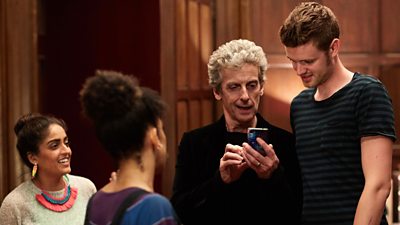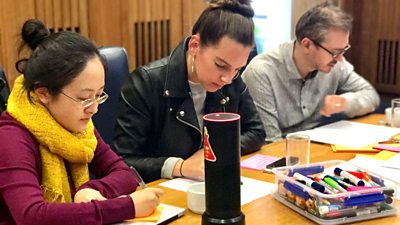As we celebrate seven years of ±«Óãtv Taster, the reasons for launching the platform for audiences to try, rate and share experiments are still as pertinent today as they were then. As we reflect on its seven years of audience feedback and testing innovation, the team discussed the many things we've learned along the way, and it was hard just to focus on the top seven. But before we start, a short history if I may...

Taster was born out of the need to get experiments out to audiences fast, not 18 months later down the roadmap schedule. We wanted to hear and learn from our audiences' thoughts about new technology concepts that tackled some tough challenges facing the ±«Óãtv in reaching audiences.
It began as a joint venture between ±«Óãtv Research & Development and ±«Óãtv Three, to ensure we benefitted from our combined technical and editorial expertise. Through R&D's Connected Studio initiative, we partnered with some incredible people and companies within the creative sector to contribute experiments or pilots to the Taster pipeline. Literally hundreds of pilots.
Taster has been a way for ±«Óãtv R&D to test its technology and experiences directly with the public and at scale; otherwise it would not have been possible. Take a recent example of ±«Óãtv Together, the ability to watch programmes in different locations at a synced time.
It launched during a global pandemic and has shown great success in entertainment and drama, like RuPaul's Drag Race. There's currently nowhere else to test these types of experiments within the ±«Óãtv. Without Taster, we wouldn't have been able to showcase these pilots that bring multidisciplinary talent together, nor could we have engaged with the public for feedback on our innovation.
To date, we've had over 23 million visitors, and over 9.3 million of those were brave enough to try a pilot. And a number of those experiments have won awards from the , the and even a .
- ±«Óãtv R&D - Interactive storytelling: Audience analysis from ±«Óãtv Taster
- ±«Óãtv R&D - 3 years of ±«Óãtv Taster
Over the last few years, although we've had fewer pilots on Taster, those pilots have been increasingly shifting towards community makers with our help and facilitation through ±«Óãtv MakerBox. This is helping us offer people new ways to engage with the ±«Óãtv, providing tools to makers and driving adoption of technology and new formats throughout the UK and the world.
This brings me on to the lessons we've learned:
1. Build confidence by testing with the public
It's vital that the audience see what we're trialling and testing. This proves that the ±«Óãtv is continually developing new ideas and creating more value through innovation, often leading the way. Asking audiences to try, rate and share experiments gives them an insight into the future ±«Óãtv but makes them feel part of the journey. An incredible number of people have been willing to try new things and tell us what they think about them.
This builds trust in the pilots that test well, where audiences say they want to see more of this from the ±«Óãtv. This also creates confidence inside the ±«Óãtv - showing that audiences are engaged with an experiment reduces the risk for others when testing something new. A great example of this is the number of interactive video platforms that we trialled in 2014, which led to for a two year trial of TouchCast. Taster reduced risk and provided trust all-round.
2. Driving the adoption of new formats into the wider ±«Óãtv is still very challenging
Even when the audiences told us they wanted to see more, the infrastructure wasn't quite there to transfer these formats into business as usual, and ±«Óãtv teams often felt too out of their comfort zone to experiment in new ways. The workflows between linear and digital storytelling are still quite different, and the learning curve for some is too steep. Although we're trying to break down the barriers to drive adoption, more needs to be done in bringing those workflows closer together.
We've learnt that one-off experiments, even award-winning pilots, are not enough to enable the wider organisation to start making digital experiences in that way. We needed a body of work, such as our virtual reality (VR) pilots, to show the breadth and opportunity to the rest of the ±«Óãtv. This can then influence further investment for all ±«Óãtv teams, and indeed for VR, it led to the launch of Reality Labs and VR Hub.

3. Content is key
New tech alone is not enough to win the audience; you need the right mix of editorial, content and technology to really engage. You know you've got the technology right when you don't even notice it. When the pilots were all about technology and lacked in content, audiences couldn't quite get into the story, and the experience would become jerky.
Pilots tested well when we engaged a fan base, whether Doctor Who or His Dark Materials, as the content leads audiences to try something new. When it resonates with them, the impact of the technology then elevates the experience.
4. Audiences want to participate
Pilots consistently performed well when the experiments required active participation. There were clear outliers - "tell me something about myself" pilots (audiences were eager to get insights about themselves) - but also experiments allowing them to understand perspectives that they wouldn't otherwise be able to, by putting users in the shoes of others. "We Wait" is told from the perspective of a migrant crossing the Mediterranean, and "How to Survive a Nuclear Bomb" asks the user to make difficult decisions to survive.
These types of pilots saw a significant number of users more likely to return and try again.Whether telling personalised stories with objects, participation through voice and conversational user interfaces or increasing the immersivity through binaural sound and XR - these all allow the ±«Óãtv to develop further how we make more personalised stories. It also informs us in R&D to move ahead with object-based media and building tools such as StoryFormer and Audio Orchestrator to help creators make such experiments.
5. Keep it simple and make it fun!
It has to be clear to the audience what exactly you're testing - something that intrigues the curious but isn't too confusing. This can be challenging since often we're trialling technology that is new and hasn't been seen before, so having clear messaging or intuitive design is essential.
Audience attention can be very short, so you need to have the least friction possible when trying an experiment. As I mentioned earlier, content is crucial and is often the reason why some audiences to try something new, so it's best not to make that journey too arduous. Keep it simple, and definitely make it fun!

6. Widen the opportunity for the community of practice
The community of practice helps drive innovation at speed by learning from each other and reduces small teams' bottlenecks. It has given us insight into what digital creativity can mean for the ±«Óãtv. Working with the creative industry, academia, freelancers, other ±«Óãtv teams and our colleagues within R&D has helped us push the envelope on these experiments.
Together we've been able to test new technology, source new talent, trial new storytelling formats, and evaluate new designs for product. More recently, we've given the creative and tech industries the tools to facilitate new ideas and the opportunity to publish those to ±«Óãtv Taster. A community maker element to Taster is emerging and driving the adoption of technology beyond the traditional industry, allowing the UK creative sector to thrive from individual makers and companies.
7. Multi-skilled teams make it work
It takes a lot of people to manage a platform such as ±«Óãtv Taster. Trialling formats and content that have never been tried before poses many questions and risks that wouldn't usually rise within ±«Óãtv practice. Pushing the boundaries inevitably starts by changing the way we work, the way we interact with the creative sector and how we develop our infrastructure to integrate with established ±«Óãtv systems where possible.
All this requires multidisciplinary teams to want to make it happen, together. Teams from product (those that set the strategy and manage the ±«Óãtv online services), engineering, legal, project management, data protection, production, editorial policy makers - the list goes on. Without having such great people who have a passion for driving innovation, we wouldn't be able to continue to trial our experiments at scale and with the public.
A huge thanks to everyone involved in ±«Óãtv Taster over the past seven years.
- -
- ±«Óãtv Taster
- ±«Óãtv R&D - Interactive storytelling: Audience analysis from ±«Óãtv Taster
- ±«Óãtv R&D - 3 years of ±«Óãtv Taster
- ±«Óãtv R&D - How we made the Audio Orchestrator - and how you can use it too
- ±«Óãtv MakerBox - Audio Orchestrator
- ±«Óãtv R&D - Building our Community of Practice
- ±«Óãtv Connected Studio
- ±«Óãtv R&D - Where Next For Interactive Stories?
- ±«Óãtv R&D - Storytelling of the Future
- ±«Óãtv R&D - StoryFormer: Building the Next Generation of Storytelling
- ±«Óãtv R&D - StoryKit: An Object-Based Media Toolkit
- ±«Óãtv Taster - Try Click's 1000th Interactive Episode
- ±«Óãtv News - Click 1,000: How the pick-your-own-path episode was made
- ±«Óãtv Taster - Watch Instagramification
